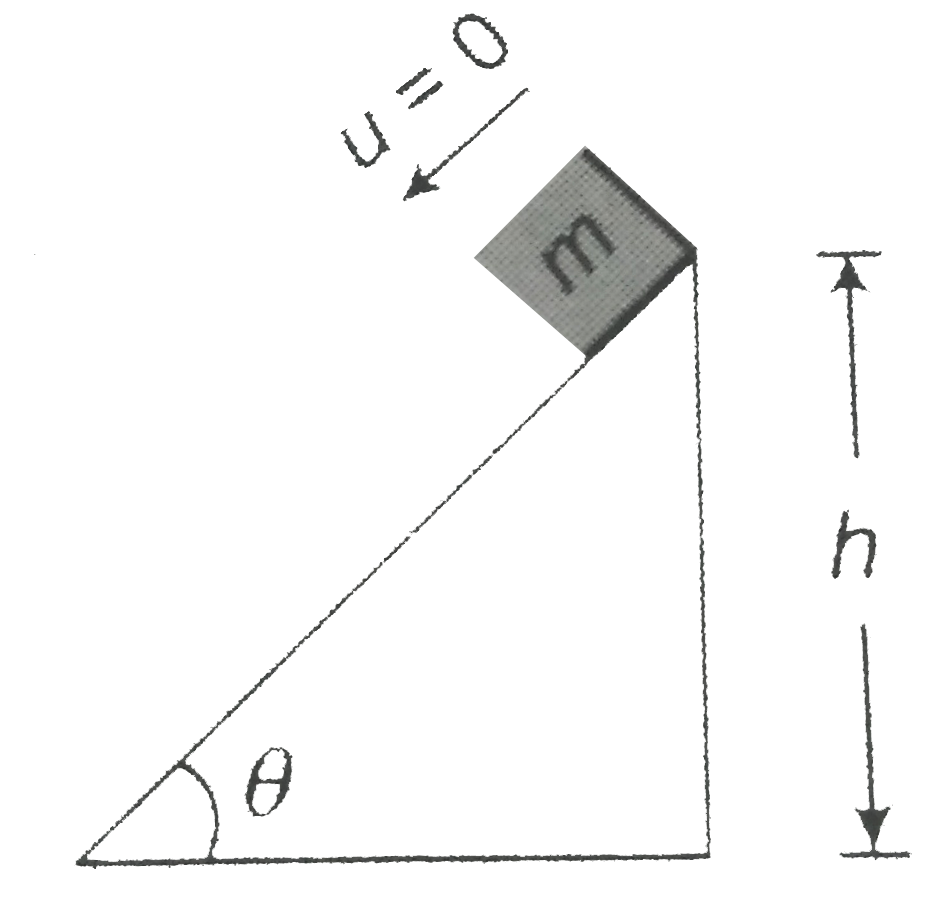A block is kept on an inclined plane of inclination θ of length l. the velocity of particle at the bottom of inclined is (the coefficient of friciton is μ)
√2gl(μcosθ−sinθ)
√2gl(sinθ−μcosθ)
√2g(sinθ+μcosθ)
√2g(cosθ+μsinθ)
The correct Answer is:B
a=g(sinθ−μcosθ),s=1
v2=u2+2as, u = 0
⇒v=√2as=√2gl(sinθ−μcosθ)
Topper's Solved these Questions
- BOOK - ERRORLESSCHAPTER - FRICTION EXERCISE - PAST YEARS QUESTIONS11videos
FRICTION
- BOOK - ERRORLESSCHAPTER - FRICTION EXERCISE - ASSERTION & REASON8videos
FRICTION
- BOOK - ERRORLESSCHAPTER - FRICTION EXERCISE - NCERT BASED QUESTIONS (Kinetic Friction )20videos
FRICTION
- BOOK - ERRORLESSCHAPTER - FLUID MECHANICSEXERCISE - ASSERTION AND REASON23videos
FLUID MECHANICS
- BOOK - ERRORLESSCHAPTER - GRAVITATIONEXERCISE - Assertion and Reason25videos
GRAVITATION
Similar Questions
A block is kept on a inclined plane of inclination q of length l. The velocity of particle at the bottom of inclined is (the coefficient of friction is μ
View SolutionA block is released on an smooth inclined plane of inclination θ. After how much time it reaches to the bottom of the plane?
 View Solution
View Solution
Knowledge Check
- Question 1 - Select One
An object is placed on the surface of a smooth inclined plane of inclination θ. It takes time t to reach the bottom. If the same object is allowed to slide down a rough inclined plane of inclination θ, it takes time nt to reach the bottom where n is a number greater than 1. The coefficient of friction μ is given by:-
Aμ=tanθ(1−1n2)Bμ=cotθ(1−1n2)Cμ=tanθ√1−1n2Dμ=cotθ√1−1n2 - Question 2 - Select One
A block is released from the top of an inclined plane of inclination θ. Its velocity at the bottom of plane is v. If it slides down a rough inclined plane of the same inclination , its velocity at bottom is v/2. The coefficient of friction is
A34cosθB14cosθC14tanθD34tanθ - Question 3 - Select One
A block moves down a smooth inclined plane of inclination θ. Its velocity on reaching the bottom is v. If it slides down a rough inclined plane of some inclination, its velocity on reaching the bottom is v/n, where n is a number greater than 0. The coefficient of friction is given by -
Aμ=tanθ(1−1n2)Bμ=cotθ(1−1n2)Cμ=tanθ(1+1n2)Dμ=cotθ(1+1n2)
A block of weight 1 N rests on a inclined plane of inclination θ with the horizontal. The coefficient of friction between the block and the inclined plane is μ. The minimum force that has to be applied parallel to the inclined plane to make the body just move up the plane is
View SolutionA block of mass m slides from the top of an inclined plane of angle of inclination θ & length l. The coefficient of friction between the plane and the block is μ. Then it is observed over a distance d along the horizontal surface having the same coefficient of friction μ, before it comes to a stop. Find the value of d.
View SolutionA block of mass m is placed on a rough inclined plane of inclination θ kept on the floor of the lift. The coefficient of friction between the block and the inclined plane is μ. With what acceleration will the block slide down the inclined plane when the lift falls freely ?
View SolutionA block moves down a smooth plane of inclination θ. Its velocity on reaching the bottom is v. If it slides down a rough inclined plane some inclination, its velocity on reaching the bottom is v/n, where n is a number greater than 0. The coefficient of friction is given by:
View SolutionA block is placed on an inclined plane. The angle of inclination of the plane is such that the block slides down the plane at a constant speed. The coefficient of kinetic friction is
View Solution

